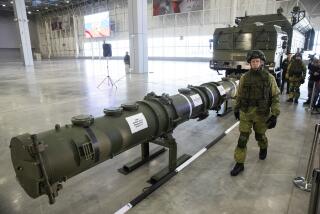Making the Most of Soviet Progress : What better time to cut the nuclear arsenal?
Washington decision-makers spent long hours this past week wondering who, if anyone, was in control in Moscow. Everyone hopes it never happens again--but the fact that it happened even once should settle any question about the worth of nuclear arms control and the urgency of putting arms-reduction treaties into effect.
Presidents Bush and Mikhail S. Gorbachev signed START I last month, agreeing to the first-ever cuts in intercontinental nuclear missiles.
The U.S. Senate should move swiftly to address the treaty, which would reduce strategic warheads in each country by about 35%. It should give the same priority treatment to the Conventional Forces in Europe treaty, calling for large cuts in both Eastern and Western ground forces.
President Bush and his military advisers must plunge back into follow-up talks to make even deeper cuts, regardless of the protestations by arms-control negotiators that they were exhausted by the last round. They should also bear down on agreements to cut chemical weapons.
The sense in Washington since START was signed is that the Senate will get around all in good time to hearing and voting on ratification. The impression was that signing the treaty was enough work for a while and that dismantling the most destructive weapons in world history might wait.
The coup by communist hard-liners in Moscow says differently.
There is no conclusive evidence that nuclear weapons entered the minds of the eight gray plotters.
Whether the codes that are needed to unlock nuclear silos and fire missiles ever fell into the hands of unauthorized officials may never be known. Both countries deliberately spread a certain amount of confusion about precisely how the nuclear button can be pushed.
But the fact that purloining the code was even theoretically possible is a chilling reminder that even if START I were ratified at once with the demolition of missiles following closely, there still would be somewhere between 8,000 and 10,000 long-range missiles in each country. That is thousands more than either the United States or the Soviet Union would need to deter acts of aggression, an unlikely event now and perhaps for a long time.
The experts may well be right to dismiss the coup as the last gasp of the Stalinist wing of the Communist Party. If that was the last gasp, worrying aloud about nuclear codes falling into the “wrong hands” (as if there were right ones) is pointless.
Elements of the Soviet military still grumble about stripping their armies of the power to win, or even begin, an old-fashioned ground war in Europe under the CFE treaty. But few military experts in either country would miss nuclear warheads if they all disappeared, because they know better than most how awesomely destructive they are.
In recent years, the Soviets have moved to make their line of authority on strategic warheads more like that in the United States. By reserving authority to launch nuclear weapons to the “highest authority” they have reduced the risk that renegades down the chain of command might commandeer nuclear weapons and let fly at the United States. Before the coup, a State Department official used one word to describe the chances of launching nuclear weapons without orders from the top: Low.
The turmoil in the Soviet Union last week shook the highest authority in Moscow. That the nuclear strike code did not come loose is reassuring. If the experts are wrong to surmise that the attempted coup was the last gasp of the right, the key to the nuclear arsenal might elude conspirators a second time--if luck holds.
But those eerie hours in Moscow remain the most eloquent kind of argument for getting rid of as many nuclear weapons as possible and in the shortest possible time.
More to Read
Sign up for Essential California
The most important California stories and recommendations in your inbox every morning.
You may occasionally receive promotional content from the Los Angeles Times.









